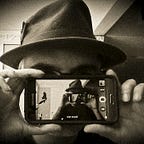Q & A with RICHARD KOCI HERNANDEZ
The internet has turned our world into a Tardis. What I mean by this is that it is both large and small at the same time. The internet gave us so much information and access to so many people that everyone just got lost. Ironically, it has also allowed us to actually communicate with the giants and influencers of the subjects we love.
When I started this crazy project I never thought anyone would respond. To my utter amazement the people whose work I looked up to actually responded. Then something even more insane occurred. One of the questions I ask everyone is who are your major influences and nearly everyone responded Richard Koci Hernandez. Well he was kind enough to actually answer my questions.
So without further ado here are his answers:
1) Why do you use a cellphone in your work? What does it allow you to do that a traditional camera does not?
My main reason for using a cell phone in my photographic work is the devices immediacy and its reach. In my experience as a photographer, there has never been a device better suited to shooting, processing and delivering photographic images so immediately. It has become my camera, dark room and printing press, not to mention delivery truck all in my pocket. I am in love with the potential of shooting, post-processing and sharing globally in just a few clicks. It’s a device that’s always with me and allows me to be more creative and experimental and receive immediate feedback.
2) How is mobile photography different from traditional photography? is it a different art form?
I don’t know that in its purest sense that mobile photography is any different than traditional photography. I think the largest distinction to be made is the fact that mobile photography is closer to a software-enabled vision. What I mean is that the abundance of software tools to expand the image is clearly more present than in traditional analog photography. For example, you can add multiple layers on top of an existing image, in the form of stickers and other software-related augmented reality apps that were unheard of with traditional photography. On a practical level, I haven’t found much of a difference when it comes to lighting, composition and moment, all of the key ingredients for any image are the same despite the device..
3) What do you wish your cell phone could do that it currently cannot?
I wish the optics were better, longer focal lengths.
4) What do you see as the future of mobile photography?
I really believe that the future of mobile photography is simply photography. I believe that the segregation of mobile as a different kind of Photography will simply fade away as more people understand and accept the idea that a cell phone is merely a new device in which to practice an old art form.
5) What should people read / view / listen to to better understand mobile photography?
Simply study the photographs that inspire you. Try and consume and think about photography more than you practice it. I know that sounds counter-intuitive but I believe that we shoot too much and think and study too little the art and craft of image-making.
6) What topic would you like me to investigate more in terms of mobile photography?
Nothing that I can think of offhand, but I am very interested in what you think and find out in terms of mobile photography really not being all that different from traditional photography.
7) Who are your major influences / who do you follow in terms of mobile photography?
This is a hard question to answer because I’m a big fan of the image and less a fan of the person behind the image. Normally that means that I’m loving and liking photography on a daily basis, it’s inspiring and at times, overwhelming, so much so that I have trouble following the mobile creators themselves. I hope that makes sense. I’m still a lover of the old masters of the craft, Bresson, Koudelka, Winogrand, Arbus, Levitt, Decarava, etc.
